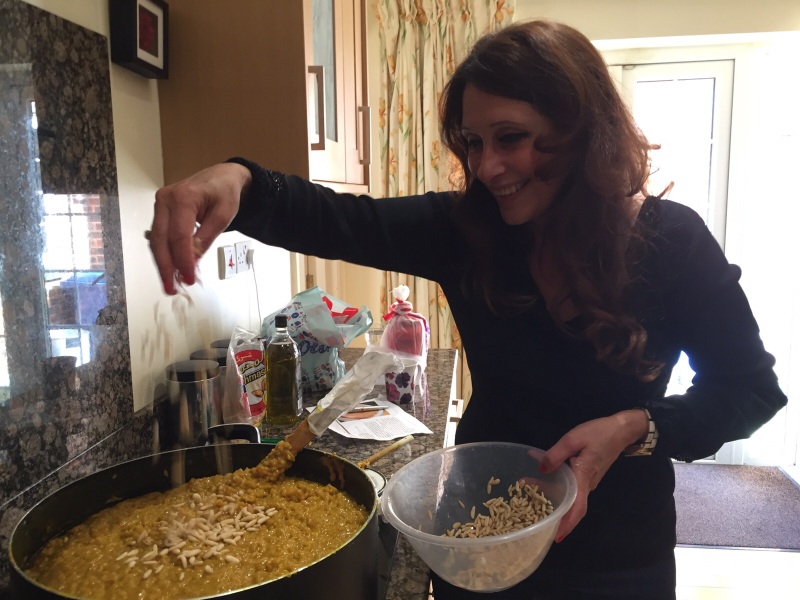 There’s no way around this. It’s no beauty. In fact it’s downright ugly. Maybe it’s the colour — a rather ill-looking brown — or the texture. But moufatka dares you to like it. That may be one reason why you don’t find it in Lebanese restaurants. This is very much a dish that you make at home and bring out on special occasions. But that’s what makes it such a treat for those who see past its unfortunate looks. Even its name is off-putting. I am not quite sure how to translate it, but “gutbuster” might be getting close.
There’s no way around this. It’s no beauty. In fact it’s downright ugly. Maybe it’s the colour — a rather ill-looking brown — or the texture. But moufatka dares you to like it. That may be one reason why you don’t find it in Lebanese restaurants. This is very much a dish that you make at home and bring out on special occasions. But that’s what makes it such a treat for those who see past its unfortunate looks. Even its name is off-putting. I am not quite sure how to translate it, but “gutbuster” might be getting close. 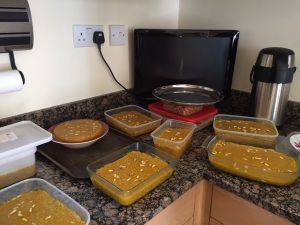 That must be due to the heaviness of the rice and the heaps of sugar. But in a way it’s healthy, too, thanks to the turmeric that is key to its taste. Turmeric is best known for use in curries — and it’s long been vaunted as something of a medicinal marvel, helping to prevent heart disease and cancer. In Lebanon, it’s used in sweet rather than savoury dishes — the best known is the cake, Sfouf, for which I have already provided a recipe. Certainly, Sfouf has inherited the better genes — it’s a much lighter and nicer looking pudding, which tastes pretty much the way it looks. Moufatka sits there sullen and lowering. There are descriptions of it that immediately spring to mind that could put you off not just moufatka but food in general for a very long time. But it is deceptive — as estate agents like to say. And it can spring big surprises. My husband stayed clear of it for days as if it were radioactive. Lack of anything else to eat in the fridge finally forced him to try a piece. He was an instant convert. One of my best friends from Beirut is also married to an Englishman. He’s more likely to be chomping on Mars Bars and crisps. But I was stunned to see how he took to the moufatka — wolfing it down hot rather than cold. All the moufatka I had in the house was made up of the leftovers from a recent moufatka making frenzy with Lebanese friends. They were all strangely excited as we were preparing it, as if it were the most decadent of treats. If you like it, I have to warn you that it is addictive. But it’s just as likely that you will hate it and never want it anywhere near you again. As with so many of the recipes here, for me it’s an instant hit of nostalgia taking me back to the pastry shop by the fountain in the old Beirut souks where I used to sit with my father on our little expeditions just before the war. My sweet tooth is one of the few things I brought with me when I left many years later. I had always thought of it as a very Beiruti dish — but I’ve since found it that it’s made in other Lebanese cities like Sidon. And I discovered there’s an Egyptian version, too, but it looks very different. Also, it’s perhaps worth pointing out that we pronounce it moufat’a, not moufatka. In our Lebanese dialect, we drop the “k” sound, which is the Arabic letter Qaf.
That must be due to the heaviness of the rice and the heaps of sugar. But in a way it’s healthy, too, thanks to the turmeric that is key to its taste. Turmeric is best known for use in curries — and it’s long been vaunted as something of a medicinal marvel, helping to prevent heart disease and cancer. In Lebanon, it’s used in sweet rather than savoury dishes — the best known is the cake, Sfouf, for which I have already provided a recipe. Certainly, Sfouf has inherited the better genes — it’s a much lighter and nicer looking pudding, which tastes pretty much the way it looks. Moufatka sits there sullen and lowering. There are descriptions of it that immediately spring to mind that could put you off not just moufatka but food in general for a very long time. But it is deceptive — as estate agents like to say. And it can spring big surprises. My husband stayed clear of it for days as if it were radioactive. Lack of anything else to eat in the fridge finally forced him to try a piece. He was an instant convert. One of my best friends from Beirut is also married to an Englishman. He’s more likely to be chomping on Mars Bars and crisps. But I was stunned to see how he took to the moufatka — wolfing it down hot rather than cold. All the moufatka I had in the house was made up of the leftovers from a recent moufatka making frenzy with Lebanese friends. They were all strangely excited as we were preparing it, as if it were the most decadent of treats. If you like it, I have to warn you that it is addictive. But it’s just as likely that you will hate it and never want it anywhere near you again. As with so many of the recipes here, for me it’s an instant hit of nostalgia taking me back to the pastry shop by the fountain in the old Beirut souks where I used to sit with my father on our little expeditions just before the war. My sweet tooth is one of the few things I brought with me when I left many years later. I had always thought of it as a very Beiruti dish — but I’ve since found it that it’s made in other Lebanese cities like Sidon. And I discovered there’s an Egyptian version, too, but it looks very different. Also, it’s perhaps worth pointing out that we pronounce it moufat’a, not moufatka. In our Lebanese dialect, we drop the “k” sound, which is the Arabic letter Qaf.  We do this for most words where it appears — so we also produce mana’ish, rather than manakish — the delicious Lebanese pizzas, which I’ve been making for a cafe recently in Twickenham while the World Cup Rugby was being played there. Most of the fans were after a beer before the game, but there were some who fancied something different like a Lebanese guy from the US, who had an unexpected passion for rugby — even having played for the American national team. But that is pretty much a definition of the Lebanese, turning up somewhere unexpected and doing something you wouldn’t expect them to do. I didn’t have any moufatka in the cafe — I think it would be a hard sell to shift it — but I am sure that if I had, it would have taken his mind completely off the rugby for a moment or two and back down a tunnel towards some long lost memory — a Lebanese version of the madeleines in Proust. Not as dainty, but just as effective…
We do this for most words where it appears — so we also produce mana’ish, rather than manakish — the delicious Lebanese pizzas, which I’ve been making for a cafe recently in Twickenham while the World Cup Rugby was being played there. Most of the fans were after a beer before the game, but there were some who fancied something different like a Lebanese guy from the US, who had an unexpected passion for rugby — even having played for the American national team. But that is pretty much a definition of the Lebanese, turning up somewhere unexpected and doing something you wouldn’t expect them to do. I didn’t have any moufatka in the cafe — I think it would be a hard sell to shift it — but I am sure that if I had, it would have taken his mind completely off the rugby for a moment or two and back down a tunnel towards some long lost memory — a Lebanese version of the madeleines in Proust. Not as dainty, but just as effective…
Ingredients
500g of pudding rice
6 glasses of fresh water
2 large spoons of turmeric
1/2 tea spoon of cinnamon
1 kilo of caster sugar
500g of Lebanese tahini
50g of pine nuts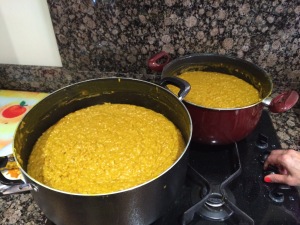
Wash the rice a couple of times then soak in hot water for an hour or over night
Put the rice in a large non stick pan, add water, turmeric and cinnamon, and put the pan on medium heat
Stir the rice constantly until the water starts to boil, reduce temperature to the minimum, and stir until the water evaporates
Make sure the rice never sticks to the bottom of the pan
Leave the pan on the hob and add the sugar, tahini and stir well for another 30 minutes, then cover the pan with the lid and cook for an hour
Make sure the pan is always on minimum temperature and stir the rice every 3 to 5 minutes until it becomes one big sticky dough and no longer sticks to the edge of the pan
This should take 1 hour at least
Add half of the pine nuts and stir for a further 30 minutes – you will see a small amount of the oil surfacing on top and around the rice
Remove from the hob and divide the dough in 7 portions
Put each portion in a flat plate and smooth the top with a spoon
Sprinkle the rest of the pine nuts equally between the plates and leave to cool
Serve chilled
Please note the more you stir the Moufatka the more elastic a texture it will have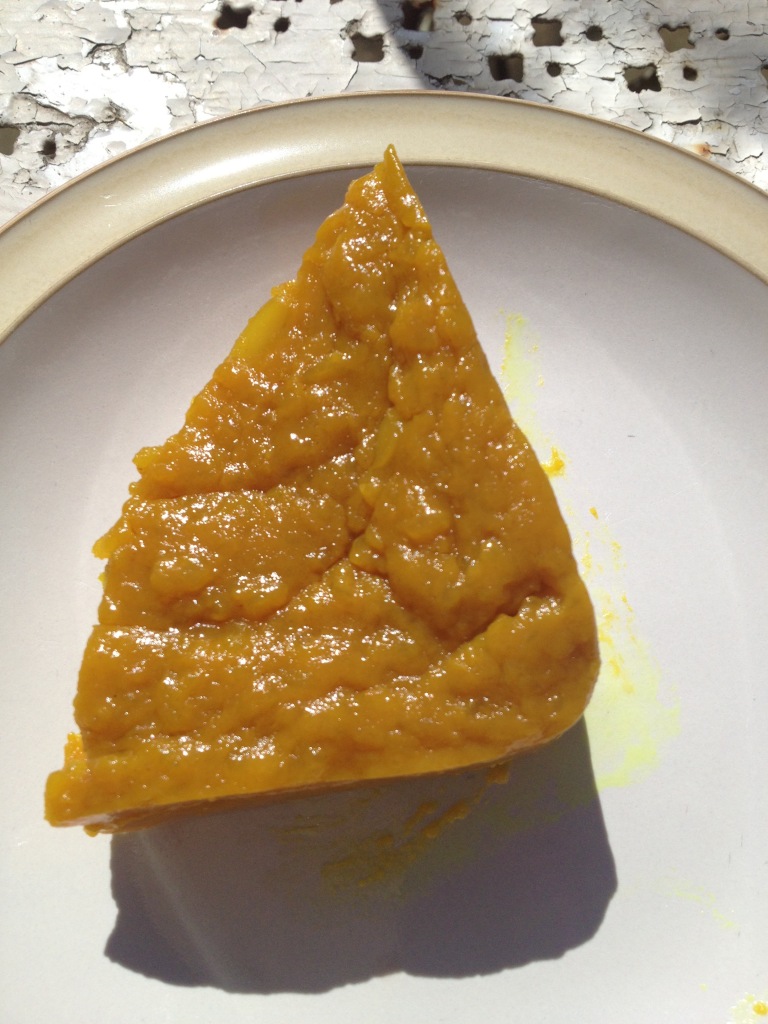

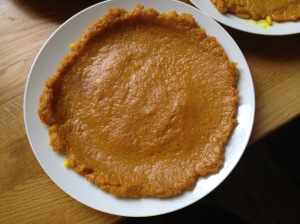
Greetings from your birthplace Beirut! I really love the way you described moufatka, sullen, lowering, “gustbuster” hahaha, it just cracked me up! But you are soooo right, it IS ADDICTIVE. I always used to wonder why on earth would Beiruti people slave away in the kitchen to make a weird looking dessert. It was only until I tried it that I knew and understood the great tradition behind it. My mom has inherited my grandma’s cooking skills and is the official “moufatka” and “arnabieh” torch carrier in the family 🙂 needless to say, she has strong muscles from all the rigorous stirring. I’m sure she’d love to read your recipe and compare ingredients. I’ll be sure to check all your remaining recipes soon! Have a good day!
Zeina
LikeLike
Hi — thanks so much for that – it’s a pleasure not just to make the dishes but to recount stories and memories around them — am sure many of them shared by others — give my regards to your mum
LikeLiked by 1 person
Hello,
I really enjoy reading your blog. I am still deciding if I should give Moufata’a a try. From what I’ve read, Would it be similar to meghli?
LikeLike
it’s a bit more hardcore I’d say — perhaps an acquired taste but i love it…
LikeLike
Not really, but give a try. You will love it if you like turmeric.
LikeLike
I love all your dishes . You make cooking big meals so easy . Moufatka is one of my favorite desserts and it always seems a big deal to make but not with you. YOU ARE AWESOME!!! I will definitely try it. Thanks for sharing it.
Sawsan
LikeLike
Thank you!
LikeLike